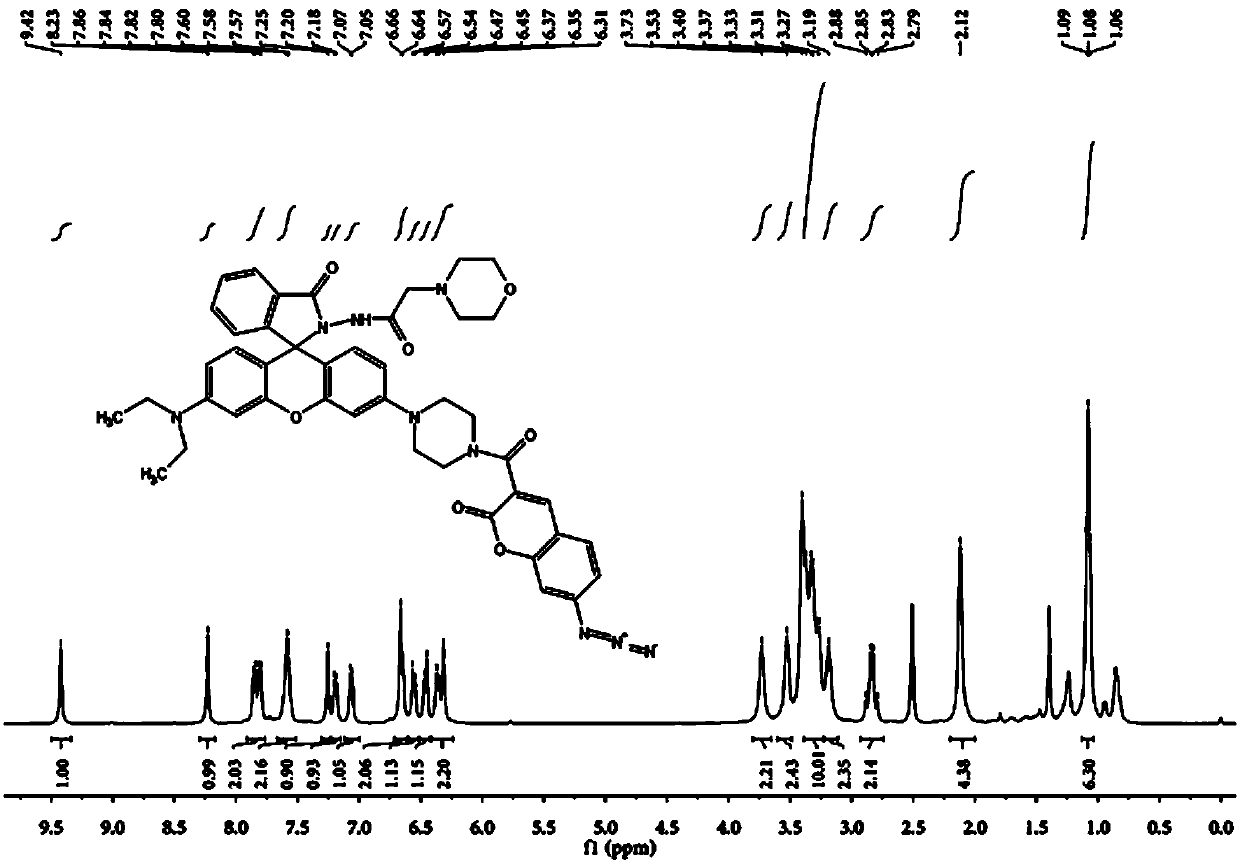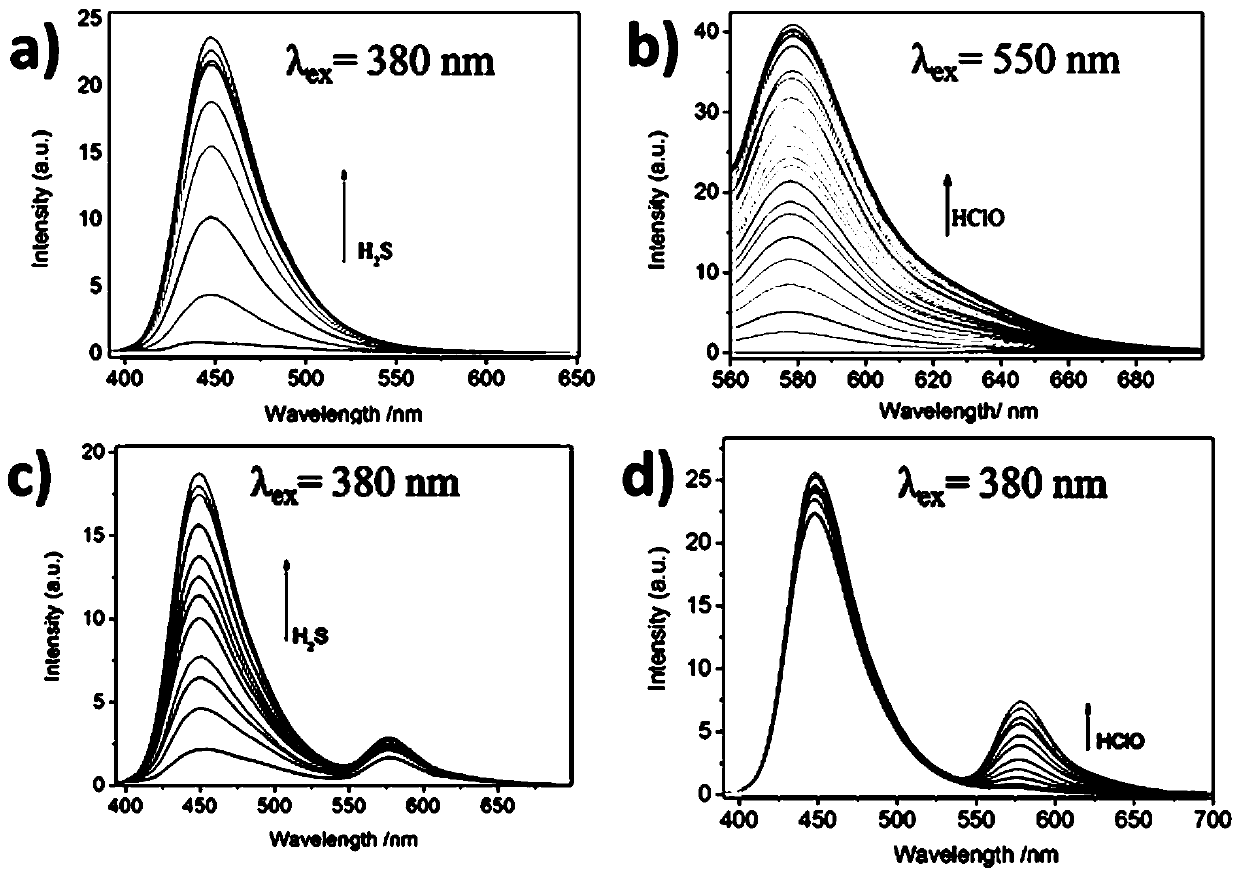A fluorescent probe for simultaneously or separately detecting hydrogen sulfide and hypochlorous acid in cell lysosomes and its preparation method and application
A fluorescent probe and lysosome technology, applied in the field of analytical chemistry, to achieve the effect of reducing direct signal interference, good resolution, and broad application prospects
- Summary
- Abstract
- Description
- Claims
- Application Information
AI Technical Summary
Problems solved by technology
Method used
Image
Examples
Embodiment 1
[0047] Synthesis of Probe Lyso-HS-HA:
[0048] (1) Synthesis of Compound FP-2
[0049]
[0050] Compound FP-1 (1.5 g, 3.2 mmol, 1 eq) was dissolved in 25 mL of ethanol, 5 mL of 80% hydrazine hydrate was added, under nitrogen protection, the reaction was heated under reflux for 1 hour, and the reaction was detected with a TCL plate. After the reaction was complete, the pressure was reduced After spin-drying the solvent, the crude product was obtained and separated by a silica gel column. The silica gel particle size was 200-300 mesh, and the eluent ratio was dichloromethane / methanol=10:1. The product FP-2 was obtained with a yield of 82%.
[0051] (2) Synthesis of Compound FP-4
[0052]
[0053] Compound FP-2 (140 mg, 0.52 mmol, 1 eq) was dissolved in 3 mL of DMF, stirred at room temperature, 1-hydroxybenzotriazole (HOBt) (70.2 mg, 0.52 mmol, 1 eq), carbodiimide (EDCI) (100 mg, 0.52 mmol, 1eq), reacted for half an hour, then added compound FP-3 (245 mg, 0.52 mmol, 1eq),...
Embodiment 2
[0064] Fluorescent probe Lyso-HS-HA with H 2 Changes of fluorescence spectra when S and HClO were added simultaneously or separately
[0065] The Lyso-HS-HA fluorescent probe prepared in Example 1 was dissolved in N,N-dimethylformamide (DMF) to prepare a 1 mmol / L stock solution. Take 30 µL from the stock solution and add it to a 5 mL centrifuge tube, dilute with 50% DMF and 2 mL of PBS buffer (0.1mol / L, pH=7.4), and then add different equivalents (0-10 eq) of H 2 S standard solution, made up to 3 mL with 50% DMF and PBS buffer solution, excited at 380 nm, and measured the change of its fluorescence spectrum (such as figure 2 shown in a). Probe solution along with sodium sulfide (H 2 S donor) was gradually added, and the fluorescence peak at 450 nm was gradually enhanced. The same method can test the fluorescence spectrum of the probe response to HClO as figure 2 As shown in b, the light at 550 nm is used for excitation, and the fluorescence peak at 580 nm of the probe s...
Embodiment 3
[0067] The selectivity of the two reactive sites of the compound Lyso-HS-HA fluorescent probe to different molecules or ions
[0068] Take 30 μL from the fluorescent probe stock solution in Example 2 and add them to 16 5mL centrifuge tubes respectively. After diluting with 2mL PBS, add 10 equivalents of competing molecular standard solutions to 14 centrifuge tubes respectively, one of which Do not add any ions, as a blank sample, and add 10 equivalents of hydrogen sulfide or hypochlorous acid standard solution to the other, and detect the change of the fluorescence emission spectrum of the solution after 15 minutes. Excitation light is used for spectrogram test, and the selective experiment for detecting hypochlorous acid site is to use 550 nm as excitation light for spectrogram test, and the results are as follows image 3 As shown, the selectivity histogram is shown as Figure 4 and Figure 5 shown. It can be found from the test results that other anions and reducing compou...
PUM
 Login to View More
Login to View More Abstract
Description
Claims
Application Information
 Login to View More
Login to View More - R&D
- Intellectual Property
- Life Sciences
- Materials
- Tech Scout
- Unparalleled Data Quality
- Higher Quality Content
- 60% Fewer Hallucinations
Browse by: Latest US Patents, China's latest patents, Technical Efficacy Thesaurus, Application Domain, Technology Topic, Popular Technical Reports.
© 2025 PatSnap. All rights reserved.Legal|Privacy policy|Modern Slavery Act Transparency Statement|Sitemap|About US| Contact US: help@patsnap.com



